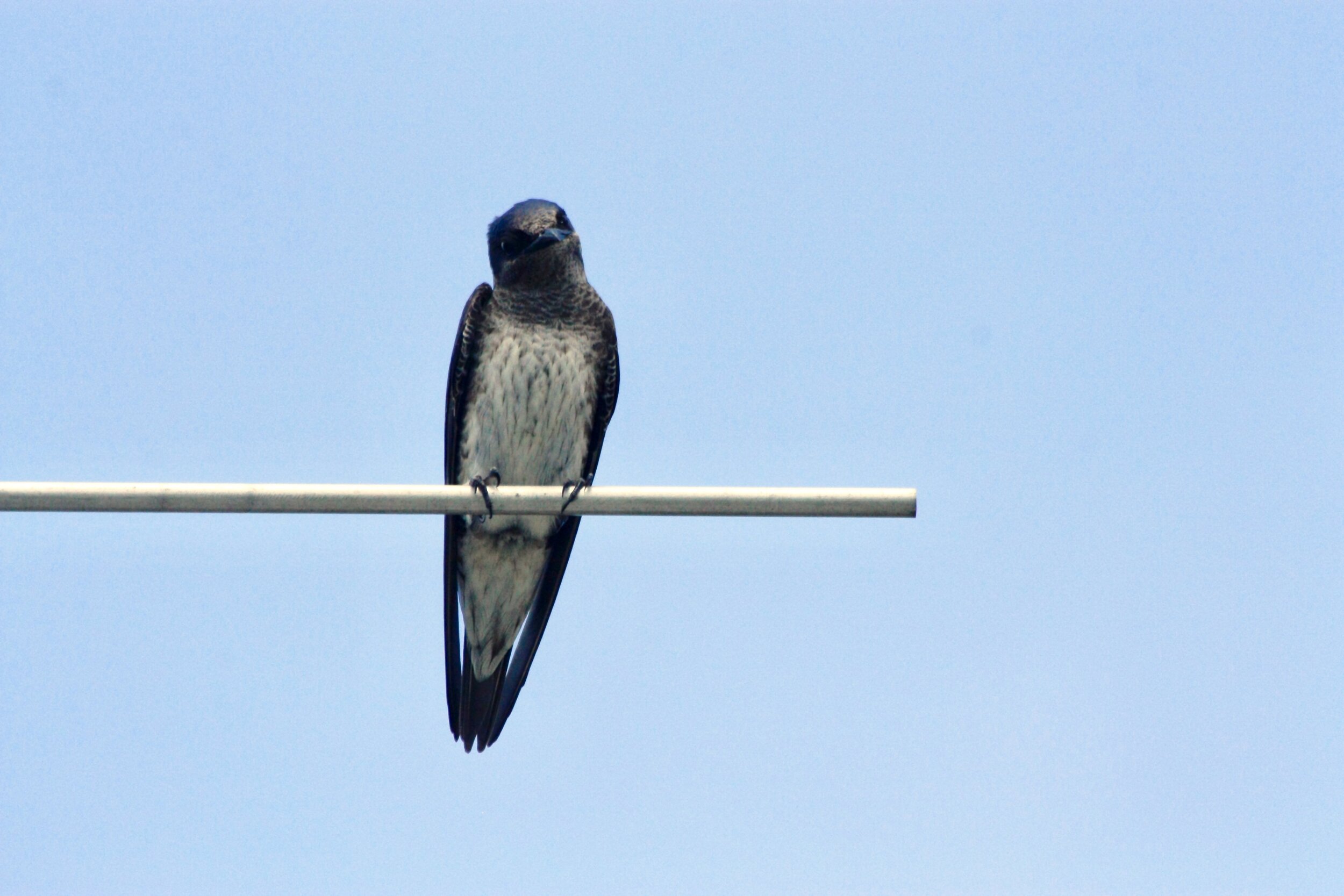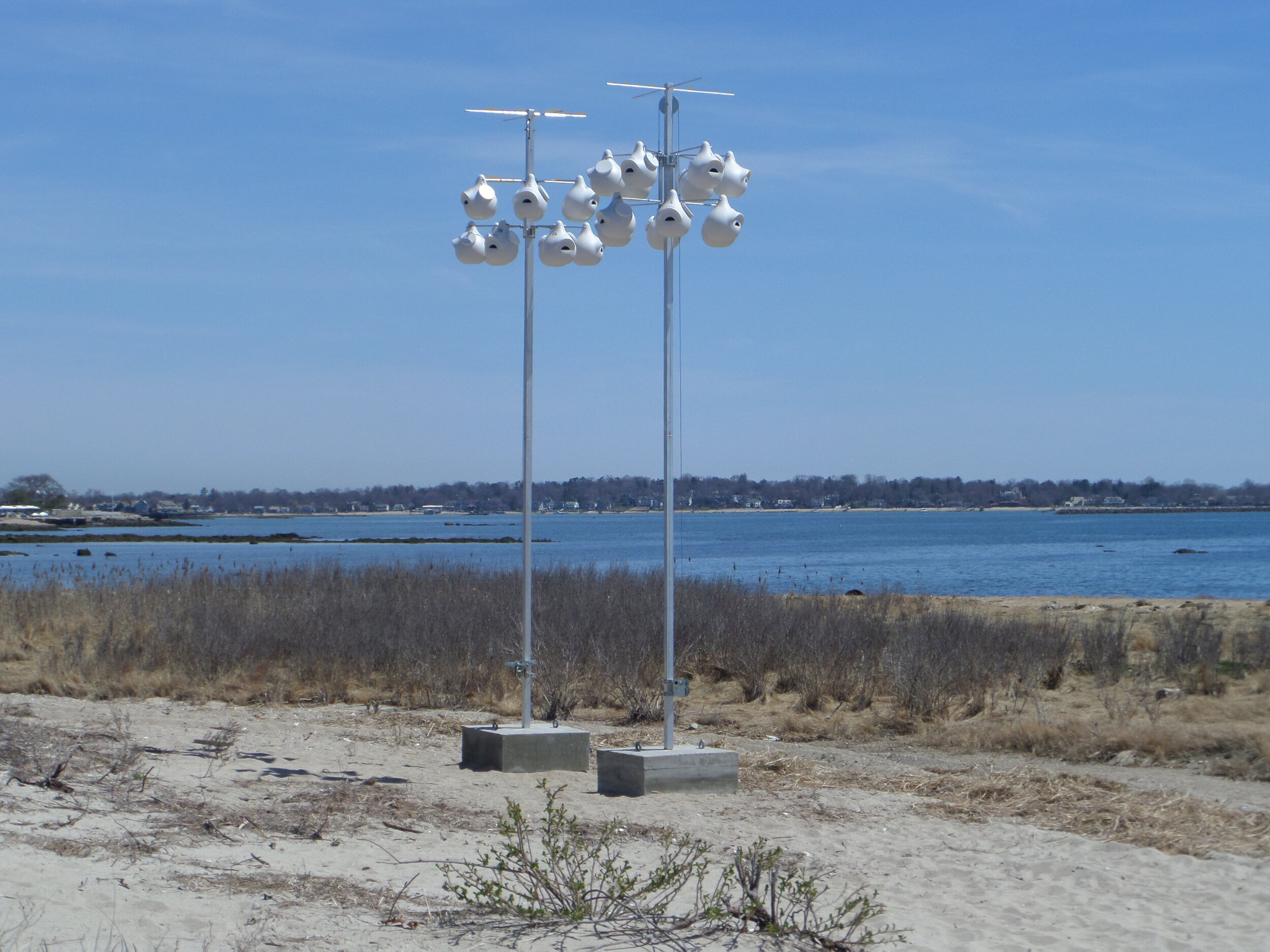Local Wildlife Weekly #1: Purple Martin
/This is part of the 2020 Digital Seaside Center. For more Digital Seaside Center content, click here.
Hi everyone,
My name is Brendan Murtha, and I’m the 2020 Bruce Museum Seaside Center Naturalist. I’ve been exploring the habitats of the Long Island Sound all my life, and have deep ties to the Sound’s wildlife and wild-lands. I hope to share some of that knowledge and wonder with you all these next few months.
Unfortunately, under current circumstances, the Seaside Center is unable to open its facilities to the public and we doubt that will change before the summer is through. While we are disappointed to lose this crucial aspect of our program, we’re hard at work to produce a wide array of digital content in its stead. As part of that initiative I’ll be writing weekly posts here on Storage Room No. 2, in addition to producing videos and other media for the center’s various platforms. The posts here may take a variety of different directions, but the core of the content will be a recurring article series highlighting little-known or underrepresented wildlife in our area. These profiles will summarize the species’ natural history, and then hone in on one topic or unanswered question that I find particularly fascinating— something that sets them apart from the pack. The goal of this series is to equip readers with a greater understanding of local ecologies while highlighting the continuing mysteries/frontiers we come across each day. It is at this confluence that the natural world dazzles brightest!
Introducing: The Purple Martin
An adult male Purple Martin at Greenwich Point Park. Photo by Brendan Murtha.
This week we’re looking at the purple martin, Progne subis. For those of you who’ve spent extensive time at Greenwich Point Park, this bird species may be one you’re familiar with: they’re relatively common there. Martins are widespread but local, nesting colonially in gourd-like nest boxes. These gourds are often arranged in a tree-like matrix several meters off the ground, a man-made structure unmistakable in its eccentricity. These structures are present at the Point and allow for close observation of nesting martins, yet many dog-walkers and joggers surely pass within feet of these birds without paying them much attention. They are not large and flashy like Egrets or Osprey, nor are they a common backyard songbird like Robins, Cardinals or Blue Jays: like most bird species in our area, they tend to fly under the radar (pun intended!) That’s a shame— martins are absolutely wonderful birds.
We’ll get back to these unique nest structures in a bit, but for now let’s get acquainted with the species’ natural history outside of human influence. Purple martins are one of seven recognized Progne in the world, a genus of swallow endemic to the New World and infamous for their similarity: where multiple species of Progne martin coexist, field identification can be next to impossible. Fortunately for us purple martin is the only Progne in eastern North America, and in the absence of its sibling-species it’s largely unmistakable. Swallows (family Hirundinidae) are a family of aerial insectivores that can be found the world over; 8 species occur in North American and the purple martin is the largest by far.
In general, swallows are recognizable by their small size, swept-back wings and swooping flight— as they pursue small insects through the air they glide and weave between objects (even people) with effortless acumen. Martins add a sprinkle of brute power to this equation, and should be respected as formidable predators in their domain. They hunt much larger insects than their smaller relatives, and generally do so at higher altitudes. I remember once hanging out near a martin colony in southern New Jersey when, all of a sudden, a huge swamp darner dragonfly fell buzzing at my feet. Crouching down to investigate, I saw it was missing its head— a martin had decapitated it in midair! Dragonflies are prized prey, but martins will also take moths, butterflies, and large flying beetles. There are reports of them trying to choke down hulking cicadas as well.
The ‘purple” martin refers to the adult male of this species, which is entirely dark, glossy indigo. Adult females retain some purple on their backs, but are a lighter brown beneath. Young martins are light brown all over with pale bellies. Martins have a wide, squat bill will a slight hook; it opens up into a gaping mouth the birds use to gulf down insects on the wing. I always find that martins have a cunning gleam to their eyes, and their cheerful, chortling calls seem to convey a similar intelligence— social birds, observation of a nesting colony will inevitably turn up a slew of interesting behaviors as birds tousle in the air, bring food to and from the nests, and soak up the sun on exposed perches.
A recently fledged juvenile Martin at the Greenwich Point colony. Photo by Brendan Murtha.
First-year male Purple Martin at Greenwich Point Colony. Photo by Brendan Murtha.
Martins love the sun and don’t well tolerate cold temperatures, just like their insect prey. Between these two re-affirming factors their summer distribution is generally capped at our northern border, and they migrate south for the winter to hawk insects over the Amazon basin. That’s right— the martins lazily cruising through Greenwich airspace in May and June feel just as at home over the coffee-brown rivers of Brazil. Powerful fliers, they can cover startling distances— migrating birds have been shown to cover over 300 miles per day, and like many other birds they hop the Gulf of Mexico in one go when crossing between continents. Martins arrive back on the Long Island Sound earlier than many other migrants, with most colonies occupied by mid-April. They depart early as well, however, heading south between late July and the very beginning of September. Here they lead a snaking caravan that many other birds will soon follow. When I see martins on the move in mid-summer, it signals a profound shift— “fall” migration has officially begun.
Martins clearly have a lot that separates them from the pack; they are unique in several regards. That being said, their most unusual quality is bittersweet: these birds have an unprecedented reliance on humans. More so than any other bird in eastern North America, martins are completely reliant on man-made nest sites. The intricate nest-gourds I described at the beginning of this profile are the only places purple martin will nest, and this has given us a strange and unparalleled responsibility for their conservation. The thing is, this human reliance is not new. It appears that, east of the rockies, martins’ exclusive conversion to man-made nest sites was complete before 1900 (nest gourds have been around for a while). Historically, martins would have nested in dead tree cavities left over by woodpecker excavations, and the small populations that persist in the southwestern US still do (as well as in Saguaro Cactus, a selection I was thrilled to observe when birding in Arizona a few years back). Yet in the eastern U.S. practically no natural nest sites have been used for over a century. John James Audubon, writing as early as 1831, reported:
“Almost every country tavern has a martin box on the upper part of its sign-board; and I have observed that the handsomer the box, the better does the inn generally prove to be”
Clearly martins’ use of nest-boxes goes back a long, long time. This poses an important question: what would they do if we stopped putting them up? Would they revert to natural cavities? Or, after so many generations, are nest-gourds truly the only sites they recognize as viable?
The widespread community of stewards who put up and maintain martin colonies are not going to let this experiment play out any time soon: perhaps the stakes are just too high. The fact that we can entice colonies of these charming birds to take hold on seaside lawns and within public parks is a conservation success story in itself: martin populations have increased over the past century, and common threats to other birds, like habitat destruction, don’t have much bearing on martin management going forward. It seems their relationship with people has been mutually beneficial.
Still, martins occupy a strange niche in our relationship with the natural world. Although the birds are thriving, is there not something a bit odd about tying them inextricably to us? Is this what we want conservation to look like? Or is criticism nit-picky and pedantic? These birds bring immense joy into peoples lives, and seem to be unbothered by their dependence (they now know no other way). Maybe that’s enough for me. Either way, observing a martin colony and all its vibrant energy is an exercise in true natural historicism— we’re looking at a phenomena in fixation, on a timeline we can fully comprehend. That’s pretty unusual, and I find it endlessly fascinating.
The old Martin gourds at Greenwich Point. These have since been taken down and a new system is set up and occupied on the back-edge of the outer marsh. Photo @ The Friends of Greenwich Point.
I hope you learned something here, and enjoyed reading. If you ever find yourself at Greenwich Point, or any other park with nesting gourds set up, keep your eyes out for martins— and reflect on the strange role they play.
Stay tuned for the next species profile!
- Brendan Murtha, 2020 Seaside Center Naturalist


















